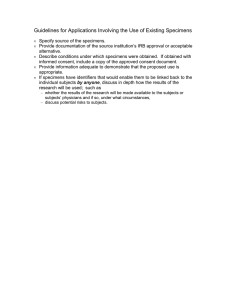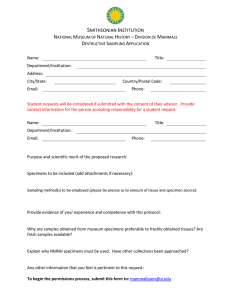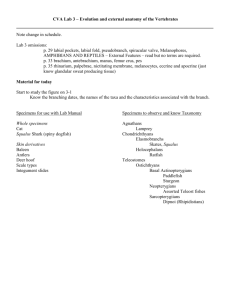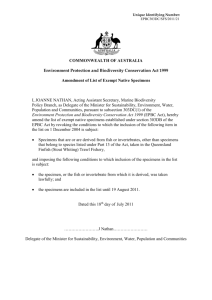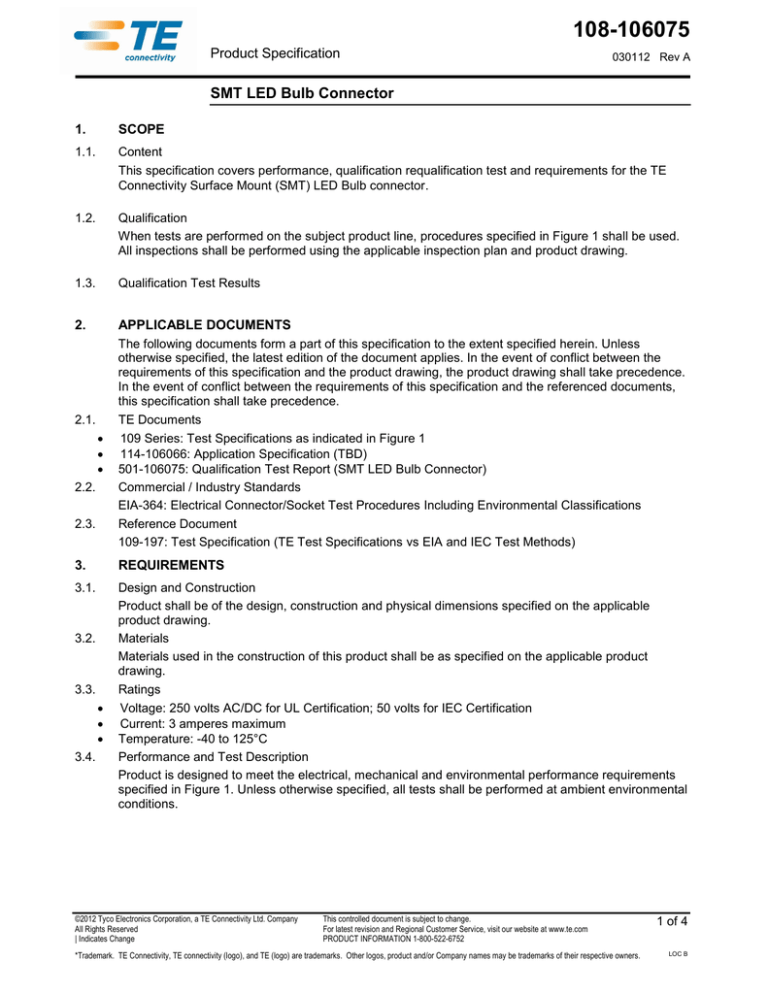
108-106075
Product Specification
030112 Rev A
SMT LED Bulb Connector
1.
SCOPE
1.1.
Content
This specification covers performance, qualification requalification test and requirements for the TE
Connectivity Surface Mount (SMT) LED Bulb connector.
1.2.
Qualification
When tests are performed on the subject product line, procedures specified in Figure 1 shall be used.
All inspections shall be performed using the applicable inspection plan and product drawing.
1.3.
Qualification Test Results
2.
APPLICABLE DOCUMENTS
2.1.
The following documents form a part of this specification to the extent specified herein. Unless
otherwise specified, the latest edition of the document applies. In the event of conflict between the
requirements of this specification and the product drawing, the product drawing shall take precedence.
In the event of conflict between the requirements of this specification and the referenced documents,
this specification shall take precedence.
TE Documents
2.2.
2.3.
109 Series: Test Specifications as indicated in Figure 1
114-106066: Application Specification (TBD)
501-106075: Qualification Test Report (SMT LED Bulb Connector)
Commercial / Industry Standards
EIA-364: Electrical Connector/Socket Test Procedures Including Environmental Classifications
Reference Document
109-197: Test Specification (TE Test Specifications vs EIA and IEC Test Methods)
3.
REQUIREMENTS
3.1.
Design and Construction
Product shall be of the design, construction and physical dimensions specified on the applicable
product drawing.
Materials
Materials used in the construction of this product shall be as specified on the applicable product
drawing.
Ratings
3.2.
3.3.
3.4.
Voltage: 250 volts AC/DC for UL Certification; 50 volts for IEC Certification
Current: 3 amperes maximum
Temperature: -40 to 125°C
Performance and Test Description
Product is designed to meet the electrical, mechanical and environmental performance requirements
specified in Figure 1. Unless otherwise specified, all tests shall be performed at ambient environmental
conditions.
©2012 Tyco Electronics Corporation, a TE Connectivity Ltd. Company
All Rights Reserved
| Indicates Change
This controlled document is subject to change.
For latest revision and Regional Customer Service, visit our website at www.te.com
PRODUCT INFORMATION 1-800-522-6752
*Trademark. TE Connectivity, TE connectivity (logo), and TE (logo) are trademarks. Other logos, product and/or Company names may be trademarks of their respective owners.
1 of 4
LOC B
108-106075
3.5.
Test Requirements and Procedures Summary
Test Description
Initial examination of
product
Final examination of
product
Requirement
Meets requirements of product drawing and
AMP Specification.
Meet visual requirements. And no corrosion
influence performance
7.2 Electrical
Test Description
Requirement
Low level contact
resistance (LLCR)
60 mΩ Max. (Initial & Final)
Insulation resistance
100 MΩ Min.
Withstanding Voltage
1 minute hold with no breakdown or
flashover
Temperature rise
(Initial)
30º C maximum temperature rise with 3A
current pass.
Temperature rise
(Final)
30º C maximum temperature rise with 3A
current pass.
Procedures
Visual and dimensional inspection per
product drawing. Per EIA364-18
Visual inspection. Per EIA364-18
Procedures
Subject specimens to 20mV Max. open circuit at
10mA. Need to exclude wire resistance from
measurement.
Per EIA364-23 or TE Spec. 109-5311-1
Subject specimens to 500VDC, 2 minute hold.
Test between adjacent contacts.
Per EIA364-21
1500 V AC at sea level. Test between adjacent
contacts.
Per EIA364-20, Condition 1
Stabilize at a single current level until 3 readings
at 5 minute intervals are within 1 º C. Energize
100% of the circuit.
Per EIA364-70, Method 1
Stabilize at a single current level until 3 readings
at 5 minute intervals are within 1 º C. Energize
100% of the circuit.
Per EIA364-70, Method 1
7.3 Mechanical
Test Description
Requirement
Procedures
Resistance to reflow
soldering heat
Housing shall be free for deformation and
fusion.
AMP Spec 109-201, Condition B.
Random Vibration
No discontinuities of 1 microsecond or longer
duration.
Subject mated specimens to 3.10G’s rms
between 20~500HZ. Fifteen minutes in each of 3
mutually perpendicular planes.
Per EIA-364-28, Test Condition Vll, Condition D.
Mechanical shock
No discontinuities of 1 microsecond or longer
duration. See note
Subject mated specimens to 30 G’s half-sine
shock pulses of 11 milliseconds duration. Three
shocks in each direction applied along 3 mutually
perpendicular planes, 18 total shocks.
Per EIA-364-27, Condition H.
Durability (Contact)
Refer to Appendix
No physical damage, and meet requirements
of additional tests specified in Product
Qualification Test Sequence (Item 8.0)
Mate and unmated specimens for 30 cycles at a
maximum rate of 500 cycles per hour.
Per EIA-364-09.
Durability
(Plastic Bump)
Refer to Appendix
No physical damage, and meet requirements
of additional tests specified in Product
Qualification Test Sequence (Item 8.0)
Mate and unmated specimens for 5 cycles at a
maximum rate of 500 cycles per hour.
Per EIA-364-09.
Mating force
20 N max
Measure force necessary to mate specimens at a
maximum rate of 12.7mm per minute.
Per EIA-364-13
Rev A
2 of 4
108-106075
Unmating force
Measure force necessary to unmate specimens
at a maximum rate of 12.7mm per minute.
Per EIA-364-13
4 N min
7.4 Environmental
Test Description
Requirement
No physical damage, and meet requirements
of additional tests specified in Product
Qualification Test Sequence (Item 8.0)
Thermal shock
No physical damage, and meet requirements
of additional tests specified in Product
Qualification Test Sequence (Item 8.0)
No physical damage, and meet requirements
of additional tests specified in Product
Qualification Test Sequence (Item 8.0)
Humidity
(Temperature cycling)
Temperature life
3.6.
Procedures
Subject specimens to 25 cycles between -40 and
125 ºC with 30 minute dwells at temperature
extremes and 1 minute transition between
temperatures.
Per EIA-364-32, Test Condition Vll.
Subject specimens to 10 cycles (10 days)
between 25 and 65 ºC at 80 to 100% RH.
Per EIA-364-31, Method lll.
Subject mated specimens to 125 ºC for 500
hours.
Per EIA-364-17, Method A, Test Condition 5.
Product Qualification Test Sequence
Test group
Initial examination of product
Low level contact resistance (LLCR)
a
b
c
d
e
f
1
1
1
1
1
1
2,10
2,8
2,6
2,6,10
2,6
Insulation resistance
3,7,11
3,7
Withstanding Voltage
4,8,12
4,8
Temperature rise (Initial)
3
Temperature rise (Final)
5
Resistance to reflow soldering heat
2
Random Vibration
6
6
Mechanical shock
7
7
Durability (Contact)
Durability (Plastic Bump)
5
5
Mating force
3,9
3
Unmating force
4,9
4
Thermal shock
9
Humidity (Temperature cycling)
5
Temperature life
Final examination of product
4
5
11
9
13
9
3
Notes:
1) Specimens shall be prepared in accordance with applicable instruction sheets and shall be selected at
random from current production. Each test group shall consist of 5 pcs specimens minimum.
2) Numbers indicate sequence in which tests are performed.
3) If changes significantly affecting form, fit or function are made to the product or manufacturing
process,
product assurance shall coordinate requalification testing, consisting of all or partial of the original test
sequence as determined by development/product, quality and reliability engineering.
4) Acceptance is based on verification that the product meets the requirement of Test Requirements and
Procedures Summary. Failures attributes to equipment, test setup or operator deficiencies shall not
disqualify the product. If product failure occurs, corrective action shall be taken and specimens
resubmitted for qualification. Testing to confirm corrective action is required before resubmittal.
5) The applicable quality inspection plan shall specify the sampling acceptable quality level to be used.
Dimensional and functional requirements shall be in accordance with the applicable product drawing
Rev A
3 of 4
108-106075
and this specification.
4.
QUALITY ASSURANCE PROVISIONS
4.1.
Qualification / Requalification Testing
A. Specimen Selection
Specimens shall be prepared in accordance with applicable Instruction Sheets and shall be
selected at random from current production. Each test group shall consist of a minimum of 5
specimens.
B. Test Sequence
Qualification inspection shall be verified by testing specimens as specified in Figure 2.
Requalification
If changes significantly affecting form, fit or function are made to the product or manufacturing process,
product assurance shall coordinate requalification testing, consisting of all or part of the original testing
sequence as determined by development/product, quality and reliability engineering.
Acceptance
Acceptance is based on verification that the product meets the requirements of Figure 1. Failures
attributed to equipment, test setup or operator deficiencies shall not disqualify the product. If product
failure occurs, corrective action shall be taken and specimens resubmitted for qualification. Testing to
confirm corrective action is required before resubmittal.
Quality Conformance Inspection
The applicable quality inspection plan shall specify the sampling acceptable quality level to be used.
Dimensional and functional requirements shall be in accordance with the applicable product drawing
and this specification.
4.2.
4.3.
4.4.
5.
Rev A
REFERENCE DRAWING
4 of 4

